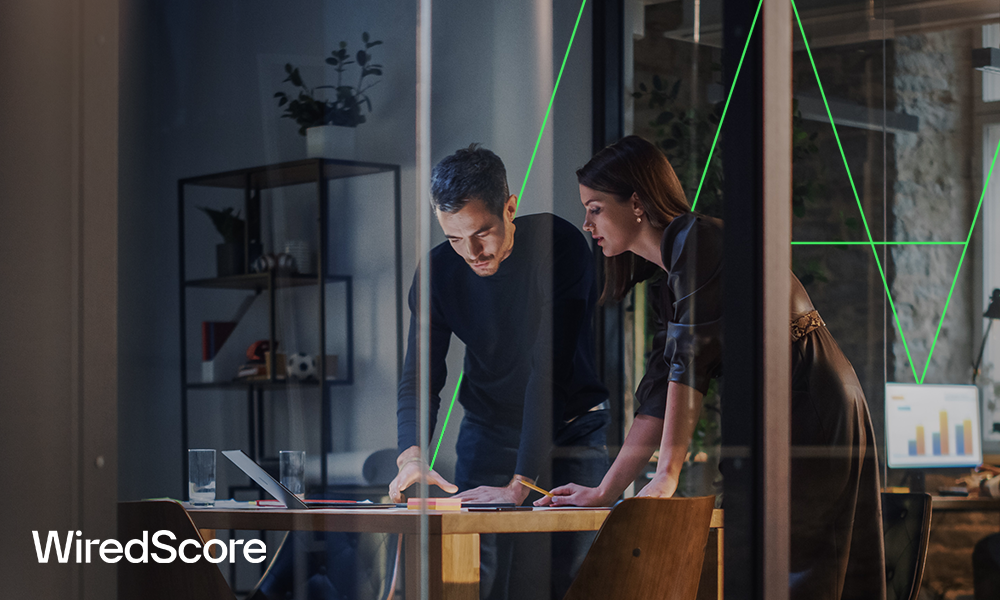When it comes to ‘smart buildings,’ what comes to mind first? Often, we think about technology and the infrastructure that make a building intelligent. We can talk about flexible access with fancy keycards, or occupancy sensors on each desk. We could delve into the many layers of connectivity that are built into today’s workspaces, with hybrid WiFi and 5G cellular backups. These are all significant ways to provide office users with real value.
However, our workplaces are changing. Office users are demanding that landlords and developers offer smarter experiences that empower and engage them. For innovative real estate players, whose revenues and economic fortunes are on the line, these experiences are most valuable when they can last for the long term.
So while connectivity and flashy technology can provide great experiences, sustainability remains a pressing priority the world over. The global consequences of unmanaged climate change threaten to sink islands and flood our cities. When we focus so much on getting smart, we can sometimes lose sight of how the built world can help to offer resilience against the changing environment around us, and even help to slow the advance of global warming.
Better Living Through Technology
An adaptable, user-first working environment through sensors, plentiful connectivity options and convenience-first features means adding to our carbon footprint. We cannot escape this initial reality. But bringing these parts together to enable sustainability is a process that looks to the future.
When buildings create an actionable stream of data about how users interact with their workspaces, they can adapt to reduce their energy consumption without disappointing their tenants. According to a joint WiredScore/Cushman & Wakefield study, “40% of the carbon impact of a building comes from the day-to-day operation – the heating, cooling, air purification, lighting, IT infrastructure, lifts and other key elements.”
So what does this mean for sustainability? It means long-term impact. When we work to create systems that dynamically manage key consumption factors according to what tenants really need, then wastage can be minimized.
Property managers can be sure they have the infrastructure in place to adapt HVAC, water, mechanical, lighting and smart interactive features to their real-time usage, enabling and reducing utility usage accordingly. Users get what they need, when they need it – and we reduce our demands on the planet’s scarce resources when they don’t. Smart features can enable sustainability.
Sustainable Office Spaces Are Future-Ready Spaces
This variability in building usage is now more significant than ever. Occupancy patterns for office space have become less predictable across the world. For developers and investors in the commercial real estate sector, it is vital that assets can face up to this modern reality – and retain their value in the process.
The most resilient assets, in a world where virtual and physical working environments coexist, are those that look to embrace an era of user-first, collaborative productivity while looking to hedge for tomorrow’s risks. Take the Hammerbrooklyn Digital Pavilion in Hamburg, Germany.
This innovative development, a repurposed expo space, outperforms its peers’ energy consumption by 45%. And by giving an existing structure a new lease of life, existing ‘embedded’ carbon stays put. In fact, day-to-day, the building is completely carbon neutral.
Aided by a SmartScore Platinum certification, Hammerbrooklyn demonstrates what can be achieved with sustainability in mind. As a state-of-the-art smart building, with over 3,000 smart sensors feeding into a core data center, occupants are empowered to customize their experience.
Much of this information is sent to user dashboards, where local alterations to service provision can be made, such as changing the lighting, heating and cooling and managing access, right down to the meeting room level, on their smartphones.
In this way, driven by smart features, Hammerbrooklyn’s management can ensure that it’s not just their users who get the information they need to achieve great experiences at work. They ensure that we all benefit from sustainable outcomes, too.
Smart Really Can Mean Sustainable – And It’s Here To Stay
So is ‘smart’ really sustainable? When we think not just about tomorrow, but about the environmental challenges to come over the next few decades, we can offer a confident answer: yes.
We know that the ability of smart technologies to rise to that challenge is strong, by uniting energy and consumption data into actionable insights.
We know that we have to commit to an initial carbon output in order to build the kinds of sensor-driven pools of data that, when managed correctly and leveraged intelligently, can allow our buildings and businesses to strive for energy efficiency and sustainability.
We also know this can be done without sacrificing our business efficiency.
That is why, globally, the commercial real estate sector is striving to create sustainable and future-ready environments where productivity goes even further and faster, while carbon emissions fall more quickly.
And that is why WiredScore assesses, certifies and improves digital connectivity and smart technology on a global scale – to give landlords, developers and tenants the power to deliver an exceptional user experience, drive cost efficiency, meet high standards of sustainability and get future-ready.
Click here to find out more about how WiredScore can help you deliver world-class outcomes for your users – and the planet – alike.

